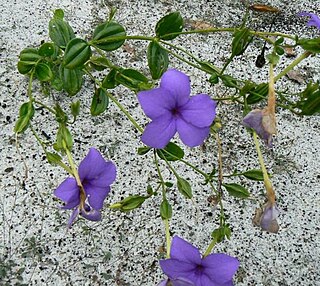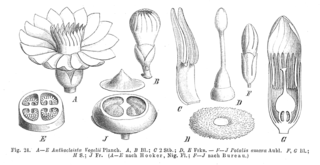
Gentiana is a genus of flowering plants belonging to the gentian family (Gentianaceae), the tribe Gentianeae, and the monophyletic subtribe Gentianinae. With about 400 species, it is considered a large genus. Gentians are notable for their mostly large trumpet-shaped flowers, which are often of an intense blue hue.

Melastomataceae is a family of dicotyledonous flowering plants found mostly in the tropics comprising c. 175 genera and c. 5115 known species. Melastomes are annual or perennial herbs, shrubs, or small trees.

The genus Macrocarpaea, with 105 species and two hybrids of 0.5 m herbs, shrubs, epiphytes and small trees to 10 m tall, is the largest genus of the tribe Helieae of the gentian family (Gentianaceae). Species of Macrocarpaea have diurnal and nocturnal pollinators, visited during the day by hummingbirds, insects and butterflies, and at night by bats, moths and many different kinds of insects. The common name for the genus is 'Moon-gentian'. No species are known in cultivation.

Chionanthus, common name: fringetrees, is a genus of about 150 species of flowering plants in the family Oleaceae.

Gentianella is a plant genus in the gentian family (Gentianaceae). Plants of this genus are known commonly as dwarf gentians.

Fagraea is a genus of plants in the family Gentianaceae. It includes trees, shrubs, lianas, and epiphytes. They can be found in forests, swamps, and other habitat in Asia, Australia, and the Pacific Islands, with the center of diversity in Malesia.

Halenia is a genus of plant in family Gentianaceae. It contains the following species :

Tetracera is a genus of flowering plants of the Dilleniaceae family native to the tropics. Several species are lianas.
The APG III system of flowering plant classification is the third version of a modern, mostly molecular-based, system of plant taxonomy being developed by the Angiosperm Phylogeny Group (APG). Published in 2009, it was superseded in 2016 by a further revision, the APG IV system.

Voyria, commonly known as ghostplants, is a genus of 20 species of herbaceous perennial plants, belonging to the family Gentianaceae. They are mostly native to warm temperate and tropical regions of the Caribbean, Central America and South America, except for V. primuloides, which is found in West and Central Africa. V. parasitica reaches as far north as the Everglades in Florida.

Spigelia is a genus of flowering plants in the family Loganiaceae. It contains around 60 species, distributed over the warmer parts of the Americas, from the latitude of Buenos Aires to the Southern United States. It was named after Adriaan van den Spiegel by Carl Linnaeus in his 1753 Species Plantarum; the type species is Spigelia anthelmia. Pinkroot is a common name for plants in this genus.

Sebaea is a genus of annual plants in the family Gentianaceae. Species occur in Africa, Madagascar, India, China, Thailand, Australia and New Zealand. The genus was paraphyletic and has been split in four genera: Exochaenium, Klackenbergia, Lagenias and Sebaeas.str.. Synapomorphies for Sebaea s.str. include the presence of extra stigma along the style and the shape of the testa cells of the seeds.

Rauvolfioideae is a subfamily of the flowering plant family Apocynaceae. Many species are woody lianas, others are shrubs or perennial herbs.

Exaceae is a flowering plant tribe in the family Gentianaceae. Exaceae comprises about 180 species assigned to eight monophyletic genera, with major centres of endemism in continental Africa, Madagascar and the southern tip of India and Sri Lanka (14 endemic species).

Tachiadenus is a plant genus in the gentian family (Gentianaceae), tribe Exaceae. It contains 12 species. The genus is endemic to Madagascar.

Symbolanthus, the ring‐gentians, are a genus of flowering plants in the family Gentianaceae, native to the montane tropics of southern Central America and northern and eastern South America.

Souroubea is a genus of flowering plants in the family Marcgraviaceae, native to southern Mexico, Central America, Trinidad, and northern South America. Some species are psychophilous, and some are sphingophilous.
Chelonanthus is a genus of flowering plants belonging to the family Gentianaceae.
Curtia is a genus of flowering plants belonging to the family Gentianaceae.

Potalia is a genus of flowering plants belonging to the family Gentianaceae.

















